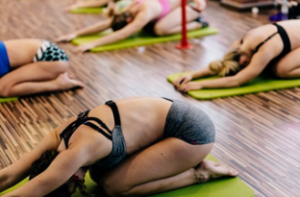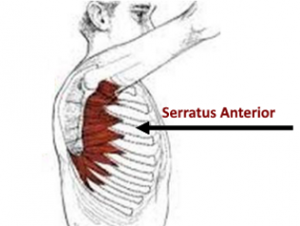Many people complain of achy muscles and bones after a hard day’s work or when they finish one of their favorite activities. And while it is understandable to hurt after working, we all wonder why it hurts when we are doing something we love.
Despite the fact that we may have done a particular activity for years, we still use muscles that may not have been worked before. Also, the very repetitive nature of a specific pose or swing can still cause the muscles to become weak and sore.
Often, this happens when we have trained or practiced too hard, or when we have gone longer than normal at the same activity. We might have strained something and not realized during a fast-paced game.
One of the biggest reasons for tendon, ligament or muscle discomfort is the simple fact that the warm-up and cool-down routines were ignored. Most of us are in a hurry and we don’t think about the benefits to our bodies by maintaining proper regimens.
 And, although it may seem like a bit of a dichotomy, stretching to improve muscle soreness is the most important aspect of feeling better.
And, although it may seem like a bit of a dichotomy, stretching to improve muscle soreness is the most important aspect of feeling better.
Indeed, the conundrum of wanting to rest versus exercising when we hurt is strong enough that many people forgo the exercises.
Of course, we are not suggesting a rigorous pulling of muscles and tendons, or even a cardio session. All that has been done during the activity that caused the aching in the first place.
Why Does Stretching to Improve Muscle Soreness Make Sense Even Though the Body Hurts?
Stretching to improve muscle soreness makes sense even though the body hurts because it prevents muscle stiffening and shortening, which can hinder mobility. Stretching restores muscle function by revitalizing blood flow to the muscles.
This will deliver oxygen and essential nutrients, and remove toxic metabolic waste, which initiates the recovery process. It also lengthens and relaxes tight muscles to increase flexibility and ease tension.
Stretching also stimulates the release of endorphins – which act as natural pain relievers – and this will ultimately improve performance and alleviate soreness.
The truth is that gentle stretching is exactly what those sore muscles need.
Therefore, we have outlined seven common conditions, and discuss the need for stretching to help alleviate the discomfort associated with them.
#1 Stretches To Reduce Inflammation
Muscle inflammation can be a short-term situation that stretching and ice packs can relieve. For more chronic situations, although certain types of stretches may be recommended, it is equally as important to seek medical advice on the condition.
In fact, there is a serious disease called Myositis, which has been documented to affect all ages. The muscles become so inflamed that they are weak, tired, and in some instances swell up.
Everyday tasks and chores are hampered, and the whole body aches, as it is incredibly difficult to move around.
Often, there are other symptoms, and this does require a proper diagnosis and treatment. For most people, physiotherapy and exercising will be recommended.
As long as you discuss the right stretches to perform with your medical expert, then you should feel the benefits of stretching to improve muscle soreness.
#2 Stretches For Sore Biceps, Triceps and Shoulders
The upper body gets a considerable workout while doing many everyday tasks. Lifting is a primary cause of biceps, triceps and shoulder pain.
It is even worse when repetitively lifting over one’s head. Or having to hold in a position with the arms over the head for a prolonged period of time.
Overuse of the upper muscles such as might happen when lifting or practicing the same swing over and over again in any racquet sport often creates a burning, tingling sensation in the arm between the elbow and the shoulder.
This is called the biceps muscle because it consists of two tendons that attach it to the shoulder and the elbow.
The triceps muscle is in the back of the arm and includes three heads called the medial, lateral, and long.
As you put pressure on both the biceps and triceps, the shoulder absorbs some of the strain, causing it to hurt, as well. Plus, when holding the arms over the head, the shoulder is responsible for the flexible rotation.
One simple exercise to release the tension in the arms is to hold a towel between the two hands down the back of the body.
One arm is held slightly above the head, while the other is positioned underneath the shoulder blades. The arms are bent at the elbows. The towel should be in a straight line between the upper and lower arm.
#3 Stretches For Sore Groin Muscle
Pain in the groin can be intense. Every movement of the leg exacerbates the discomfort, and it is increasingly difficult to move the leg up and down. Using the stairs is fraught with pain, and simple chores like lifting the leg up to put on one’s boots can be excruciating.
You might wonder how you managed to strain that area of all places on the body. Frequently, it comes from changing shoe height. For example, you might wear a high heel and then switch out to flats.
Or you might change from an unsupportive shoe like flip-flops at the beach in the afternoon, to a pair of boots in the evening. The constant changing of heights causes the muscle in the groin to expand and contract. If it is too short, you feel the pain with ferocity.
Oddly, for women, it is more common for the right groin muscle to start hurting from some strain or injury in the leg attachment. There might be a tear in the ligament, tendon or muscle. Very active individuals are prone to this type of damage.
Hip conditions such as arthritis or fracture, as well hernias, pinched nerves, and kidney stones are other reasons why the groin may hurt.
Once serious conditions have been ruled out, then stretching to improve muscle soreness is an effective form of action.
#4 Stretches For Tailbone Relief
Scientifically known as the coccyx, the tailbone is found at the bottom of the spine. Originally, when we had tails, that would have been where the tail started. Although it appears to serve no purpose like before when the tail was needed for stability, now it does, however, support the pelvic area.
When the tailbone hurts, you can feel it when sitting in certain positions that place pressure on the area. Being bedridden for some time or sitting for long periods are main culprits of a very sore tailbone. Severe falls in the backward direction can damage the bones in the tailbone.
Since the tailbone is closely aligned with the pelvis, and the pelvis supports the vagina, stretches that strengthen the pelvic area will also benefit a stiff tailbone.
A simple way to stretch out the coccyx, is by pulling the knee up to the body and giving it a good hug.
#5 Stretches For Sore and Stiff Neck Muscles
We can all use a pick-me-up throughout the day. Whether we are working hard that requires physical labor, or we are thinking hard at our desk, the neck tends to take the brunt of our actions. The result is stiff or sore muscles.
Since you may be limited in what exercises you can perform because of your location, one stretch that is acceptable anywhere is this one.
Lift your neck as though you were looking at the sky. Continue until your head tilts backward and you can’t move it any further. At the same time, keep your back and shoulders still. Don’t move them.
Hold your pose for a few seconds, then release, and start again for four repetitions.
Remember to breathe deeply while resting.
#6 Stretches To Help Relieve Wrist Pain
Sprained wrists, carpal tunnel syndrome, and general soreness in the wrist can all be treated with stretching. In the case of a sprain, however, the wrist may have to heal some before you are allowed to do any exercises.
For instances where you have a sore wrist from doing a particular activity such as skiing, gardening or typing, you will be keen to start stretching to improve muscle soreness. The sooner you can gently stretch out the area, the better you will feel.
When the wrist is sore, many individuals automatically try to shake it out. This helps a little, but proper stretching will do even more.
For such a small area of the body, there are several effective wrist flexors that you can try, but a quick and easy one can be done in seconds.
Stretch your arm outwards with your palm facing down. Point the fingers and thumbs toward the floor and with your free hand push them down farther. You will feel the stretch on the top of the wrist.
As with all exercises to stretch out muscles and alleviate pain, go smoothly and tenderly. Don’t force the parts to do anything that is abnormal or makes the pain worse.
#7 Stretches For Tingling Fingers and Numbness
It’s hard to believe that even the fingers have muscles. To look at them and feel them, it seems like there is only flesh and bones. But in reality, many muscles exist in order for the hands to have proper mobility.
The flexibility of the fingers is controlled by complicated mechanisms in order to perform intricate tasks such as playing the piano, typing on a keyboard, or tying knots and shoe laces. The other role of the fingers is to act as one entity when lifting items or grabbing onto something.
And while many injuries can and do happen to the fingers, two ailments that many people suffer is tingling in the fingers or the opposite, numbness.
Now, this can be a very temporary situation caused by the temperature of your environment. For example, if you are unpacking the groceries, and have a lot of frozen items, your fingers might feel tingly or numb depending on how long you are working in the freezer.
That’s why we instinctively stretch our fingers and hands. We open wide and close them several times to get the blood moving again and restore the proper feelings and movements.
Final Thoughts on Stretching to Improve Muscle Soreness
Without doubt, stretching to improve muscle soreness is a proven and accepted form of treatment prescribed by the medical community for various conditions. Needless to say, we prefer that you always seek proper advice before diagnosing and treating yourself.
Whether you embark on stretching for your warm-up and cool-down exercises, or you have been instructed by medical professionals to do specific stretches, there are many benefits associated with stretching muscles.
The fact of the matter is the body feels better after a good stretch. Endorphins are released, the blood vessels are relaxed helping the heart to pump more efficiently, and the muscles are expanded to avoid injuries or strains.

